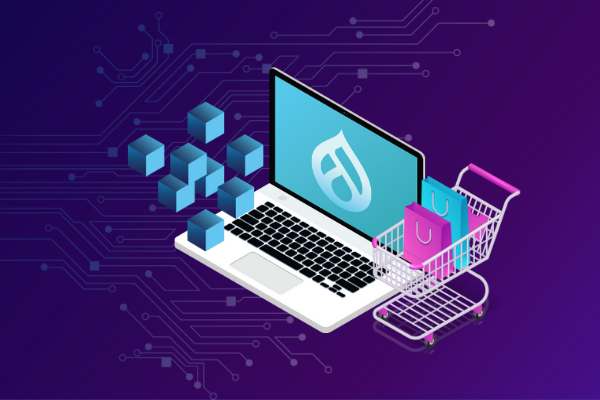E-Commerce is a significant part of the global retail market, thanks to the pandemic and rapid digitization. Its revenue is expected to grow to $6.54 trillion by 2022. Over the last few years, it has witnessed tremendous growth and progressed beyond mere buying and selling of products. It is now about personalized experiences for customers, spanning across different channels and devices.
Marquee brands have brought in monumental capabilities that take their retail game to the next level by establishing a niche customer experience. AI assisted buying and in-store assistance being some major examples.
However, this seems like a far-fetched dream for those who are just starting with e-commerce. To be able to create and deliver such niche experiences, businesses need a platform that provides them the freedom to build and leverage technology blocks of their choice and need. So, in this blog we will reflect upon the available options for e-commerce businesses and discuss the future of e-commerce.
Cherry picking the best available solution that matches your needs
Finding the right platform to kick-start e-commerce operations is an obvious prerequisite, but is easier said than done. What makes the decision even more perplexing, is the availability of multiple options to choose from and the lack of clarity of intricate details.
- Monolith - The traditional way of doing ecommerce
Defining the elements of the architecture, like the front-end and backend systems, is a basic building block that businesses need to decide on. However, not every enterprise has the expertise to make such vital decisions.
But, does that mean they shouldn’t proceed at all? Absolutely not!
For them, a full-stack or monolith architecture makes perfect sense. Its well-defined templates are effortless and easy to deploy. The simplified designs make the editors' lives easier and a minor modification in the frontend can be done (within the defined boundaries, of course), without much hullabaloo.
However, this ‘easy system’ has its own drawbacks. Of course your editors can easily make a change, but a backend issue can break your live website. Fixing issues on the backend translates to redeploying the site. It also fails to take into consideration the progressive needs of technology and customers. It is plagued with challenges like migration, maintenance, agility, customization, and scalability.
Enterprises can certainly upgrade from this cookie cutter approach, but would require investment of effort, money, time, and expertise due to higher code dependencies.
- Platform as a Service(PaaS) - The package deal setup
Enterprises often subscribe to the services of a PaaS provider. Their direct pitch -‘Hey give us your money and we’ll handle the rest’ bodes well for many. One of the biggest advantages of such platforms is that enterprises are freed from the hassle of server upgrades and maintenance, since such attributes are handled by the PaaS provider.
However, enterprises experience stagnation when expanding their business horizontally. Diversification is a real challenge in case of platform providers, which is also costly. To increase customer touchpoints across devices and customize your offerings for them, upgrading the provider services brings in additional costs. Moreover, this does not guarantee a consistent customer experience either and your developers and marketers might struggle to work together in tandem.
Security issues can be an additional, unwanted baggage with such platforms. The lack of hands-on ownership, topped with increasing costs, makes your business vulnerable.
What is Decoupled Drupal?
So, what if you could split the architecture and get the best of all worlds? How would you like to leverage technology to build exceptional experiences, know where and how your data is stored and managed, and of course, empower your marketers? Simple, Decoupled Drupal.
Decoupled Drupal is a fast-emerging option and is synonymous with absolute freedom. It allows you to separate your online e-commerce backend or data from its user interface. Headless Drupal Commerce is another popular term. However, the key differentiating factor between the Headless system and Decoupled architecture is in the presentation layer. Headless does not have a defined presentation environment, but decoupled does.
In the decoupled setup, Drupal serves the role of a robust content repository, while being free from the burden of rendering data on its front-end application. An API connects the backend with the frontend.
Our Drupal distribution, EzContent, helps enterprises experience the true essence of decoupled Drupal. While it retains the CMS must-haves for editors and marketers, developers are free to use the technology of their choice, such as Angular, ReactJS and so on.
The Decoupled Advantage - Everyone’s happy place
- Freedom to choose
As previously mentioned, it provides developers with the ability to choose from a wide range of front-end technologies.
- Reach multiple devices
Decoupled Drupal helps you implement different types of front-end applications. This enables enterprises to render their website on different devices, while having just one backend data repository, Drupal.
- Versatile content
Decoupled Drupal’s multi-tenancy also comes in very handy for creating specifically branded and localized store versions, catering to different markets. This works for brands willing to meet localization requirements and franchise rules, without needing a large workforce.
All of these contribute to making your platform completely future-proof, as you continue to deliver a rich customer experience that translates to: higher ROIs, better customer relationships, and a consistent brand presence.
The Choice, though exclusive, must be future ready!
The choice of architecture for e-commerce is not ‘one size fits all’. It is dependent on your business expectations and growth. However, the need for your business to be future-ready cannot be discounted. Your choice should be viable enough to embrace digital disruptions and evolve into a solution that is able to serve customer needs; scalability is the key here.
What makes cutting through this maze of choices, faster and easier, is a service provider who knows what you expect from your platform. Unless they are able to understand and map your expectation to the technology, the results will always be below satisfactory and demand higher investment of effort, time, and money. You can re-iterate the processes and technologies with fresh eyes every quarter, but the possibility of achieving the desired results is very slim.
At Srijan, it is not just about building a standardized ‘solution’, but one that is viable and on par with the expectations of your business right now and the foreseeable future. To see what we can build for you, get in touch with us.
Our Services
Customer Experience Management
- Content Management
- Marketing Automation
- Mobile Application Development
- Drupal Support and Maintanence
Enterprise Modernization, Platforms & Cloud
- Modernization Strategy
- API Management & Developer Portals
- Hybrid Cloud & Cloud Native Platforms
- Site Reliability Engineering




